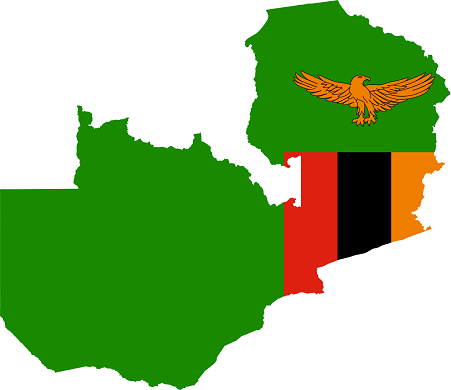How big is the land of Zambia?
The land area of Zambia is approximately 752,612 square kilometers (290,587 square miles). To provide some context, this makes Zambia slightly larger than the countries of Turkey and Chile, and roughly the size of the U.S. states of Texas or France.
Zambia is a landlocked country located in southern Africa. It shares borders with eight countries: Tanzania to the northeast, Malawi to the east, Mozambique to the southeast, Zimbabwe to the south, Botswana and Namibia to the southwest, Angola to the west, and the Democratic Republic of the Congo to the north.
The country’s landscape is characterized by diverse geographical features, including the Zambezi River, which forms Zambia‘s southern border and is renowned for its majestic Victoria Falls. Other notable features include large lakes such as Lake Tanganyika, Lake Mweru, and Lake Kariba, as well as vast grasslands, woodlands, and national parks that support a rich variety of wildlife.

Zambia’s size and geographical diversity contribute to its natural resources, agriculture, and wildlife conservation efforts, making it an important country in the region.
What is the land like in Zambia?
The land in Zambia is characterized by diverse landscapes and geographical features. The country’s topography includes plains, plateaus, mountains, valleys, and river systems, offering a wide range of habitats and ecosystems. Here are some key features of the land in Zambia:
- Plateaus: Much of Zambia consists of high plateaus, with an average elevation of around 1,000 to 1,400 meters (3,300 to 4,600 feet) above sea level. The Central Plateau is the largest and highest plateau in the country, covering a significant portion of central and eastern Zambia.
- Valleys and Rifts: Zambia is traversed by several valleys and rifts. The most prominent is the Great Rift Valley, which runs through the eastern part of the country. This rift is associated with the formation of the vast Lake Tanganyika in the north and Lake Kariba in the south.
- Rivers and Water Bodies: Zambia is renowned for its abundant water resources. Major rivers, including the Zambezi, Kafue, and Luangwa, flow through the country, providing water for irrigation, hydroelectric power generation, and supporting diverse wildlife populations. Zambia is also home to large lakes such as Lake Tanganyika, Lake Mweru, and the man-made Lake Kariba.
- Grasslands and Savannahs: Wide stretches of grasslands and savannahs are found across Zambia, particularly in the southern and eastern parts of the country. These open grassy areas support diverse wildlife, including herbivores such as wildebeest, zebras, and antelopes, as well as predators like lions, leopards, and cheetahs.
- Woodlands: Woodland areas dominate much of Zambia’s landscape, characterized by a mix of trees and shrubs. Miombo woodlands are particularly widespread, covering a significant portion of the country. These woodlands are known for their various tree species, including species of Brachystegia and Julbernardia, and provide habitat for diverse wildlife.
- Mountains and Escarpments: Zambia features several mountain ranges and escarpments. The Eastern Highlands along the border with Malawi and the Muchinga Escarpment in the northern part of the country are notable examples. These mountainous areas offer scenic landscapes, hiking opportunities, and unique ecological niches.
- Wetlands: Zambia has diverse wetland areas, including floodplains, swamps, and marshes. The Barotse Floodplain in the western part of the country, associated with the Zambezi River, is the largest wetland area. These wetlands support rich biodiversity, including numerous bird species and aquatic life.
Where is the country of Zambia and is Zambia big? Overall, the land in Zambia showcases a variety of geographical features, making it a country of remarkable natural beauty and ecological significance. The diverse landscapes support agricultural activities, wildlife conservation efforts, and provide opportunities for tourism and outdoor recreation.





